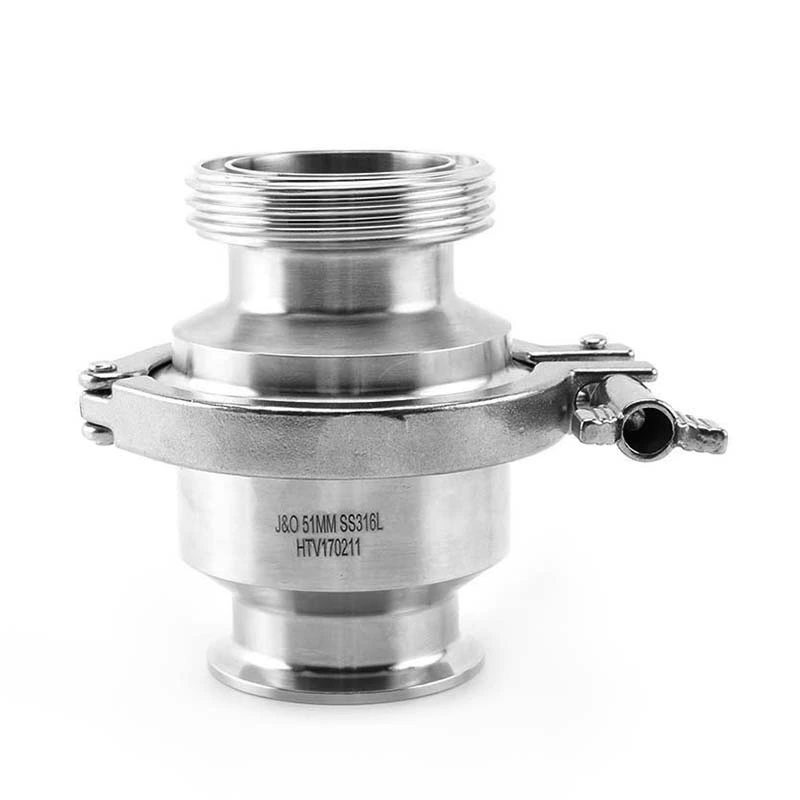Sanitary Check Valve Technical Parameters
I. Introduction
A Sanitary Check Valve is a commonly used industrial device used to control the unidirectional flow of fluid in pipelines. It prevents backflow and protects pipelines and equipment. This article will provide a detailed introduction to the definition, classification, operating principle, and common technical specifications of check valves.
II. Definition
A check valve, also known as a non-return valve or reverse flow valve, is a device used to prevent the reverse flow of fluid. It is typically installed at the outlet of a pipeline or the inlet and outlet of equipment to ensure that fluid flows in only one direction, preventing damage to equipment and pipelines caused by backflow.
III. Classification
Based on their structure and operating principle, check valves can be divided into the following categories:
1. Classification by Structure
• One-way check valve: Has only one inlet and one outlet, suitable for unidirectional flow in pipelines.
• Two-way check valve: Has two inlets and one outlet, preventing backflow in both directions.
2. Classification by Operating Principle
• Gravity check valve: Uses the weight of the valve disc and fluid pressure to close the disc, preventing backflow. • Spring-loaded check valve: The spring's elastic force closes the disc, preventing reverse flow.
• Pneumatic check valve: A pneumatic device controls the opening and closing of the disc, enabling unidirectional flow.
• Hydraulic check valve: A hydraulic device controls the opening and closing of the disc, enabling unidirectional flow.
IV. Working Principle
The working principle of a check valve is based on the principles of fluid dynamics and mechanics. When fluid flows in a pipeline, if the flow direction is opposite to the check valve's inlet to outlet, the fluid pressure pushes the disc open, closing it and preventing reverse flow. Conversely, if the flow direction is consistent with the check valve's inlet to outlet, the fluid pressure opens the disc, allowing fluid to pass smoothly.
V. Technical Parameters
Selecting the appropriate check valve requires consideration of several technical parameters. The following are some common ones:
1. Valve Body Material
The check valve body is typically made of materials such as cast iron, carbon steel, and stainless steel. Choosing the appropriate valve body material is crucial based on the properties of the medium and the requirements of the operating environment. 2. Valve Nominal Size
The valve nominal size refers to the diameter of the check valve's inlet and outlet, typically expressed in inches or millimeters. Selecting the appropriate valve nominal size based on the pipeline size and flow requirements ensures proper fluid flow.
3. Maximum Working Pressure
The maximum working pressure refers to the maximum pressure a check valve can withstand, typically expressed in megapascals or pounds-force per square inch. Select a check valve that meets the maximum working pressure requirements based on the operating environment and pipeline pressure.
4. Sealing Performance
The sealing performance of a check valve directly affects its service life and fluid leakage. Common sealing types include metal seals, elastic seals, and packing seals. Select the appropriate seal type and material based on the media characteristics and operating requirements.
5. Fluid Characteristics
Different fluids, such as liquids, gases, and corrosive media, have different flow characteristics. Selecting the appropriate check valve type and material based on the fluid characteristics ensures proper fluid flow and safe equipment operation.
6. Flow Capacity
The flow capacity refers to the maximum flow rate a check valve can withstand. Selecting the appropriate flow capacity based on the pipeline's flow requirements can prevent fluid blockage and pressure loss.
7. Temperature Range
The temperature range of a check valve refers to the maximum and minimum temperatures it can withstand. Select a check valve that can adapt to this temperature range based on the operating environment's temperature requirements.
VI. Summary
Check valves, as a common industrial device, play a vital role in pipeline systems. This article provides a detailed introduction to the definition, classification, operating principles, and common technical parameters of check valves. Selecting the appropriate check valve requires consideration of multiple technical parameters, including valve body material, nominal diameter, maximum operating pressure, sealing performance, fluid characteristics, flow capacity, and temperature range. Only by fully understanding these parameters can you select the appropriate check valve and ensure the safe operation of your pipeline system.
